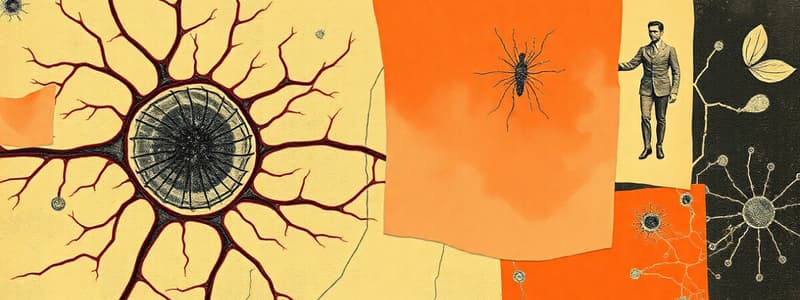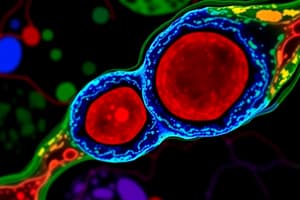Podcast
Questions and Answers
What is the primary function of focal adhesions?
What is the primary function of focal adhesions?
- Cell signaling
- Migration and cell spreading (correct)
- Protein synthesis
- Cell division
Defective hemidesmosomes can lead to skin blistering diseases.
Defective hemidesmosomes can lead to skin blistering diseases.
True (A)
What are the structural proteins that form gap junctions?
What are the structural proteins that form gap junctions?
Connexins
Gap junctions allow the passing of _______ signals and sharing of small molecules.
Gap junctions allow the passing of _______ signals and sharing of small molecules.
Match the functions of gap junctions with their descriptions:
Match the functions of gap junctions with their descriptions:
Which of the following is NOT a protection mechanism provided by barriers?
Which of the following is NOT a protection mechanism provided by barriers?
Barriers control the entry and exit of water and nutrients from the body.
Barriers control the entry and exit of water and nutrients from the body.
What are the key components in a signaling pathway?
What are the key components in a signaling pathway?
The main function of tight junctions is to provide __________ between epithelial cells.
The main function of tight junctions is to provide __________ between epithelial cells.
Match the following components related to adhesion with their descriptions:
Match the following components related to adhesion with their descriptions:
Which cytoskeletal element are tight junctions connected to?
Which cytoskeletal element are tight junctions connected to?
Tight junctions primarily protect cells from high levels of radiation.
Tight junctions primarily protect cells from high levels of radiation.
What is the primary function of tight junctions?
What is the primary function of tight junctions?
Microbes can exploit tight junctions for their benefits.
Microbes can exploit tight junctions for their benefits.
Name one function of ZO proteins in tight junctions.
Name one function of ZO proteins in tight junctions.
Anchoring junctions are common in tissues that experience high amounts of ___________ stress.
Anchoring junctions are common in tissues that experience high amounts of ___________ stress.
Match the junction type with its function:
Match the junction type with its function:
Which proteins are primarily associated with tight junctions?
Which proteins are primarily associated with tight junctions?
Anchoring junctions play a minor role in tissues that are under mechanical stress.
Anchoring junctions play a minor role in tissues that are under mechanical stress.
What two major components make up anchoring junctions?
What two major components make up anchoring junctions?
Tight junctions can be hijacked by ___________ for their own purposes.
Tight junctions can be hijacked by ___________ for their own purposes.
Which of the following is a component of desmosomes?
Which of the following is a component of desmosomes?
Desmosomes primarily connect intermediate filaments from cell to cell.
Desmosomes primarily connect intermediate filaments from cell to cell.
Name one armadillo-like protein associated with desmosomes.
Name one armadillo-like protein associated with desmosomes.
Desmosomes help maintain _______ integrity in tissues.
Desmosomes help maintain _______ integrity in tissues.
Match the following components with their respective roles in desmosomes:
Match the following components with their respective roles in desmosomes:
What type of cytoskeletal element do desmosomes connect to?
What type of cytoskeletal element do desmosomes connect to?
Desmoyokin is a component found in certain muscle tissues.
Desmoyokin is a component found in certain muscle tissues.
What is the primary function of desmosomes?
What is the primary function of desmosomes?
Desmosomes recognize ligands on neighboring cells through _______ molecules.
Desmosomes recognize ligands on neighboring cells through _______ molecules.
Match the following molecules with their characteristics:
Match the following molecules with their characteristics:
What role does E-cadherin play in embryonic development?
What role does E-cadherin play in embryonic development?
E-cadherin can be exploited by pathogens for entry into cells.
E-cadherin can be exploited by pathogens for entry into cells.
What are some factors required to produce signals that polarize an epithelium?
What are some factors required to produce signals that polarize an epithelium?
Microbes can hijack E-cadherin to gain cell ______.
Microbes can hijack E-cadherin to gain cell ______.
Match the following effects to their descriptions regarding E-cadherin:
Match the following effects to their descriptions regarding E-cadherin:
At what developmental stage is E-cadherin first expressed in mouse embryos?
At what developmental stage is E-cadherin first expressed in mouse embryos?
E-cadherin plays no role in the structure of adherens junctions.
E-cadherin plays no role in the structure of adherens junctions.
What type of cellular interactions are influenced by E-cadherin?
What type of cellular interactions are influenced by E-cadherin?
Toxins produced by pathogens can disrupt the structure of ______.
Toxins produced by pathogens can disrupt the structure of ______.
What is one way that E-cadherin is crucial for epithelial cells?
What is one way that E-cadherin is crucial for epithelial cells?
Flashcards
Barrier Function
Barrier Function
Protection against chemicals, mechanical stress, bacteria, pathogens, and environmental factors like temperature/pH/radiation; control of water, nutrient entry/exit from the body.
Epithelia GI Tract
Epithelia GI Tract
Tissue layers lining the gastrointestinal tract, with features for protection and controlled entry/exit of substances.
Signaling Pathway
Signaling Pathway
A series of linked molecules including a ligand, initiating a response.
Adhesion Molecules
Adhesion Molecules
Signup and view all the flashcards
Tight Junctions (Occluding)
Tight Junctions (Occluding)
Signup and view all the flashcards
Extracellular Matrix (ECM)
Extracellular Matrix (ECM)
Signup and view all the flashcards
Signal Pathway Components
Signal Pathway Components
Signup and view all the flashcards
Tight Junctions
Tight Junctions
Signup and view all the flashcards
Occludin
Occludin
Signup and view all the flashcards
Claudin
Claudin
Signup and view all the flashcards
ZO Proteins
ZO Proteins
Signup and view all the flashcards
Anchoring Junctions
Anchoring Junctions
Signup and view all the flashcards
Cell Membranes
Cell Membranes
Signup and view all the flashcards
Cytoskeleton
Cytoskeleton
Signup and view all the flashcards
Mechanical Stress
Mechanical Stress
Signup and view all the flashcards
Pathogens
Pathogens
Signup and view all the flashcards
E-cadherin expression
E-cadherin expression
Signup and view all the flashcards
Compaction in mouse embryos
Compaction in mouse embryos
Signup and view all the flashcards
E-cadherin's role in epithelial polarization
E-cadherin's role in epithelial polarization
Signup and view all the flashcards
Microbes hijacking E-cadherin
Microbes hijacking E-cadherin
Signup and view all the flashcards
Adherens junctions
Adherens junctions
Signup and view all the flashcards
Pathogen-cadherin interactions
Pathogen-cadherin interactions
Signup and view all the flashcards
Antibodies against E-cadherin
Antibodies against E-cadherin
Signup and view all the flashcards
Epithelial polarization
Epithelial polarization
Signup and view all the flashcards
Early mouse embryo development
Early mouse embryo development
Signup and view all the flashcards
Experiment use in biological research
Experiment use in biological research
Signup and view all the flashcards
Focal Adhesions
Focal Adhesions
Signup and view all the flashcards
Hemidesmosomes
Hemidesmosomes
Signup and view all the flashcards
What do you think would happen to the skin if hemidesmosomes were defective?
What do you think would happen to the skin if hemidesmosomes were defective?
Signup and view all the flashcards
Gap Junctions
Gap Junctions
Signup and view all the flashcards
What are the functions of gap junctions?
What are the functions of gap junctions?
Signup and view all the flashcards
What are desmosomes?
What are desmosomes?
Signup and view all the flashcards
What are the key components of desmosomes?
What are the key components of desmosomes?
Signup and view all the flashcards
Desmoglein
Desmoglein
Signup and view all the flashcards
Desmoplakin
Desmoplakin
Signup and view all the flashcards
What is the function of desmosomes?
What is the function of desmosomes?
Signup and view all the flashcards
What is the role of desmosomes in cell signaling?
What is the role of desmosomes in cell signaling?
Signup and view all the flashcards
What is the difference between desmosomes and adherens junctions?
What is the difference between desmosomes and adherens junctions?
Signup and view all the flashcards
What is the role of desmoyokin in desmosomes?
What is the role of desmoyokin in desmosomes?
Signup and view all the flashcards
How are desmosomes studied?
How are desmosomes studied?
Signup and view all the flashcards
Study Notes
Course Information
- Course Title: Biochemistry and Cell Biology
- Course Code: BS31004
- Date: October 16th, 2024
- Instructor: Inke Näthke
- Email: [email protected]
- Textbooks: "Molecular Biology of the Cell" by Alberts et al. (various editions)
Learning Objectives
- Understand different families of adhesion molecules and their structures, including other molecular components and their roles.
- Understand the differences and similarities between different cell adhesions, including specific components, ligands, signaling principles, and cytoskeletal links.
- Understand the specific functions of adhesion structures/junctions in tissues, especially epithelia.
- Understand the experimental evidence that helped identify adhesion molecules, their interacting partners, and mechanisms that mediate their function.
Multicellularity Requirements
- Requires strength and communication between cells within tissues to allow coordinated function of the entire organism as a whole.
- Cell connections relay information (mediating signals) and transmit force (physical links) through cell junctions
Cell Signaling
- All living cells sense and respond to their environment through mechanisms called cell signaling.
- These mechanisms are part of a complex network governing basic cellular activities and coordinating cell actions.
- Signaling types: (from environment to receiving cell): sending information via touching of the cell, via pushing or by secreting factors.
- Environment sends 'signals'
Epithelia
- Epithelia line the cavities of organs.
- They comprise over 80% of human cancers.
- Epithelia functions: protection against chemicals, mechanical stress, bacteria, environmental pathogens, temperature, pH, and radiation.
- They control fluid and nutrient movement across tissues.
Epithelia along the GI Tract
- Different types of epithelia (e.g., stratified squamous, simple columnar) have specific functions (e.g., protection, secretion, absorption) based on structure within different sections of the digestive system.
Tissue Layers
- Epithelial tissue
- Basal lamina
- Connective Tissue
- Collagen fibers
Lateral Membrane
- Structure and function of cell-cell anchoring junctions, channel-forming junctions, and cell-matrix anchoring junctions.
Components of Signaling & Adhesion
- Signaling Pathway Components: ligand/cue, receptor, transducer, effector
- Adhesion Components: adhesion/extracellular matrix molecules, adhesion molecules, plaque/linker proteins, signaling molecules (e.g., kinases), cytoskeleton
Cell Junctions
- Anchoring Junctions:
- Actin filament attachments (adherens junctions).
- Intermediate filament attachments (desmosomes).
- Cell-matrix attachments(actin-linked cell-matrix adhesions, hemidesmosomes)
- Occluding Junctions:
- Tight junctions (vertebrates)
- Septate junctions (invertebrates)
- Channel Forming Junctions:
- Gap junctions (animals)
- Plasmodesmata (plants)
Desmosomes
- Connect intermediate filaments between cells.
- Components include desmosomal cadherins (desmogleins, desmocollins), desmoplakin, plakoglobin, and plakophilin.
- Important in maintaining tissue integrity.
- Desmosomes are composed: cadherin-family adhesion proteins, intermediate filaments, and dense plaque of anchor proteins.
Gap Junctions
- Large protein family (connexins) form gap junctions in different tissues.
- Six connexins form one connexon.
- Mutations in connexins lead to diseases e.g. deafness.
- Pass electrical signals and small molecules (electrolytes), reducing effects of concentration fluctuations.
- Protect cells from calcium damage, closing during damage to neighboring cells.
- Gap junctions are involved in signaling networks (e.g. involving p2r, aqp, ags8, rptpp, etc)
Focal Adhesions
- Vital to cell development, especially in ectoderm, endoderm, and apoptotic cells, during attachment to the extracellular matrix (ECM) via specialized junctions.
- Essential for cell migration and spreading.
- Focal Adhesion Kinase (FAK) is important
- Components: focal adhesion kinase, talin, vinculin,a-subunit of active integrins, beta- subunit of active integrins, actin filaments.
Hemidesmosomes
- Crucial for normal skin function, connecting epithelial cells to the basal lamina.
- Deficiencies lead to blistering skin diseases.
- Composed of integrin (α6β4), type XVII collagen, laminin, and type IV collagen.
Additional notes (general summary)
- Microbes/pathogens can hijack cadherins and tight junctions for their purposes.
- Some pathogens disrupt E-cadherin structure affecting adherens junctions.
- Signaling components of junctions differ between species.
Studying That Suits You
Use AI to generate personalized quizzes and flashcards to suit your learning preferences.
Related Documents
Description
This quiz covers the critical structures and functions of various cell junctions, including focal adhesions, gap junctions, and tight junctions. It also explores the role of cytoskeletal elements and signaling pathways in cell adhesion and barrier functions. Test your knowledge on the protection mechanisms provided by these junctions and how they interact with microbes.



